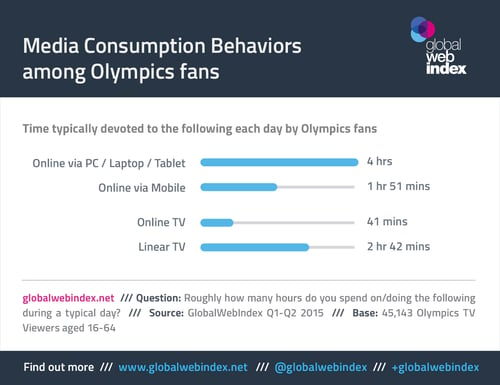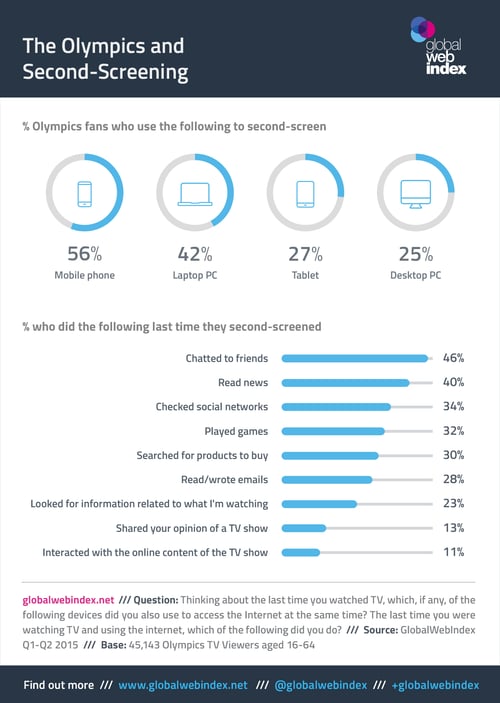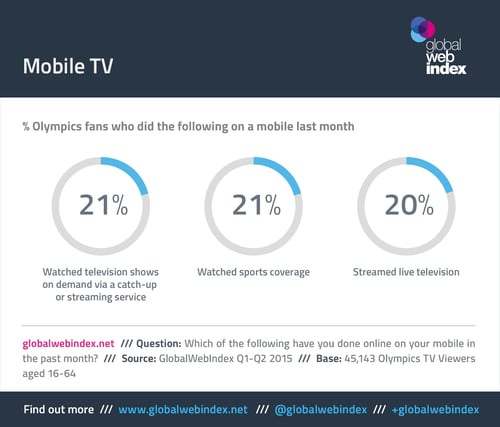With Brazil 2016 now less than a year away, GlobalWebIndex’s data makes it clear why the next Olympics will be the most mobile-centric yet.
Across our Q1 and Q2 2015 waves of research, we spoke to 45,153 internet users who say they watch the Olympics on TV. Spread across 34 different markets, it’s clear from their digital behaviors that smartphones will have a more prominent role during Brazil 2016 than at any previous set of Olympics. Here are three charts which explain why.
1. Olympics Fans use the Mobile Web for Almost 2 Hours a Day
With smartphones now ubiquitous across most demographics, fans of the Olympics are no exception – 82% say they own one, putting these devices just behind PCs/laptops.
But it’s not only widespread ownership that is important here. Just as significant is that those who will be watching the Olympics play out in Brazil will spend so much time online via their phones. Already, this audience averages 1 hour and 51 minutes of mobile web usage per day, accounting for over 30% of their total online time. And with this metric experiencing extremely consistent year-on-year rises at the moment, it’s a safe bet to say that this will have crossed the 2-hour-per-day mark before next year’s Opening Ceremony.
Online coverage could be significant, too. Although linear TV currently captures about 4x as much daily viewing time as online television, that Olympics fans are watching an average of 41 minutes of online TV each day is still pretty important – especially with 16% of Olympics viewers reporting that they have a streaming stick or device (e.g. Apple TV or Google Chromecast). Little wonder the IOC has been making noises about the roll-out of its Olympic Channel.

2. Mobile Second-Screening is Widespread
Second- or dual-screening is now an ingrained habit among Olympics viewers. An impressive 85% say they use additional devices as they watch TV and – tellingly – mobiles are now the top choice for this behavior. Already, more than half (56%) of those who will be watching Brazil 2016 say they second-screen via a phone, and that’s a figure which will rise still further in the months ahead.
What Olympics fans do as they second-screen is also pretty crucial. By some distance, the two most popular activities are chatting to friends (46%) and reading news (40%). And with social networking taking third place (34%), there can be little doubt that mobiles will be a major driver of real-time conversations and news surrounding the Olympics.

3. A Fifth Watch TV Content on their Mobile
Although TVs and then PCs/laptops remain the preferred ways to watch television, important minorities of Olympics fans are already consuming content via their smartphones. Over the course of a month, it’s about a fifth who say they watch sports coverage or stream live television.
Clearly, that means this is still a niche behavior. But that a fifth of viewers might be tuning into the Olympics via a mobile at some point during Brazil 2016 makes it fair to think of mobiles as a major content channel in their own right. Moreover, short clips are particularly popular – ask Olympics fans whether they have recently used their mobile to watch a video clip and the figure jumps to around 40%. If London 2012 was the first truly digital Olympics, Brazil 2016 could well be the first truly multi-platform one when bite-sized content is consumed across a range of channels, both on-the-go and at home.




